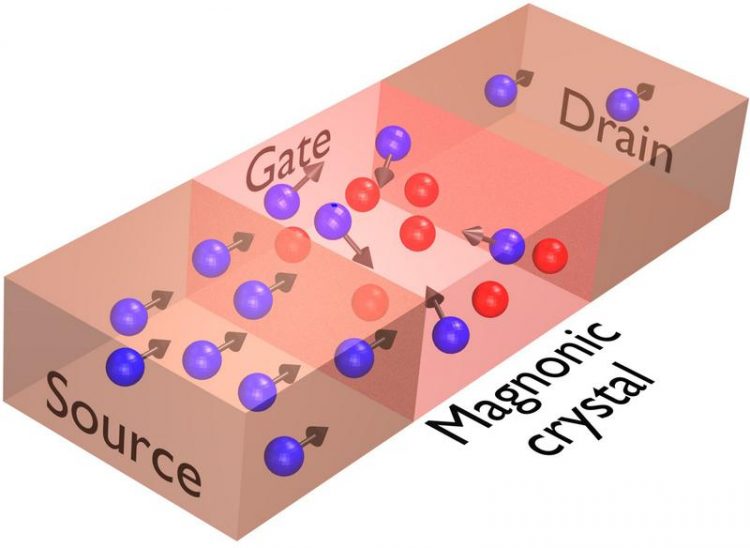Magnons control magnons: Transistors for the next generation of computing

The flow of magnons from the transistor’s Source to Drain (blue bubbles) is controlled by the magnons injected into the Gate (red bubbles)
Physicists from the University of Kaiserslautern propose the usage of magnons to carry and process information instead of electrons as it is done in electronics.
This technology opens access to a new generation of computers in which data are processed without motion of any real particles like electrons.
This leads to a decrease of the accompanying heat loss and, consequently, to lower energy consumption. Moreover, unique magnon properties allow for the utilization of alternative computing concepts resulting in a drastic increase of speed and performance of modern processors.
In a study recently published in the prestigious scientific journal Nature Communications, the Kaiserslautern scientists have realized the transistor – the main component of any modern computer – solely based on Magnons.
The transistor was proposed for the first time and a proof of concept device was demonstrated. The density of magnons in this three-terminal device could be decreased one thousand times while flowing from the transistor's Source to its Drain via the injection of magnons in the Gate.
The interaction between magnon flows was so efficient due to a strong natural nonlinearity of magnons which was enhanced using an artificial magnetic material – the magnonic crystal.
The demonstrated “magnon controls magnon” approach will be used in future for the realization of a single-chip magnetic processor in which Terabytes of data will be processed purely within the same magnonic system.
The research team consisted of Dr. Andrii Chumak, Dr. Alexander Serga and Prof. Dr. Burkard Hillebrands from the State Research Center Optics and Material Sciences (OPTIMAS) funded by the State of Rhineland-Palatinate. Further funding was obtained through the Deutsche Forschungsgemeinschaft (Grant no. SE 1771/1-2) and EU-FET (Grant InSpin 612759).
For details of the study see:
Andrii V. Chumak, Alexander A. Serga, Burkard Hillebrands: Magnon transistor for all-magnon data processing, Nature Communications 2014 doi 10.1038/ncomms5700 (http://www.nature.com/naturecommunications).
Contact: Prof. Dr. Burkard Hillebrands, Tel.: 0631/205-4228, E-Mail: hilleb@physik.uni-kl.de
Legend:The schematic of magnon transistor. The flow of magnons from the transistor’s Source to Drain (blue bubbles) is controlled by the magnons injected into the Gate (red bubbles). The decrease or even the full stop of the Source-to-Drain magnon flow was realized experimentally (Copyright: Chumak, Serga, Hillebrands).
Media Contact
All latest news from the category: Physics and Astronomy
This area deals with the fundamental laws and building blocks of nature and how they interact, the properties and the behavior of matter, and research into space and time and their structures.
innovations-report provides in-depth reports and articles on subjects such as astrophysics, laser technologies, nuclear, quantum, particle and solid-state physics, nanotechnologies, planetary research and findings (Mars, Venus) and developments related to the Hubble Telescope.
Newest articles

A universal framework for spatial biology
SpatialData is a freely accessible tool to unify and integrate data from different omics technologies accounting for spatial information, which can provide holistic insights into health and disease. Biological processes…

How complex biological processes arise
A $20 million grant from the U.S. National Science Foundation (NSF) will support the establishment and operation of the National Synthesis Center for Emergence in the Molecular and Cellular Sciences (NCEMS) at…

Airborne single-photon lidar system achieves high-resolution 3D imaging
Compact, low-power system opens doors for photon-efficient drone and satellite-based environmental monitoring and mapping. Researchers have developed a compact and lightweight single-photon airborne lidar system that can acquire high-resolution 3D…





















